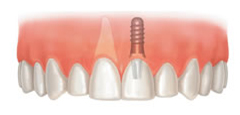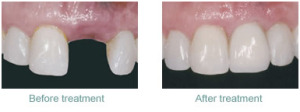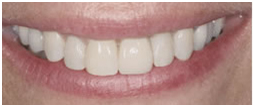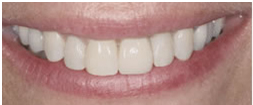
Dental implants were invented by Prof. Bran mark in Sweden some three decades ago. Since then they have been constantly developed and modified and have now been widely adopted by dental professionals and patients as the preferred method of choice to replace the lost teeth. They are very successful, to give you some idea of how successful, most studies agree that over 95% of dental implants are still functioning after 15 years. Nothing else we do in dentistry (such as fillings or crowns for example) has a comparable success rate.
Dental implants are basically, specially modified Titanium screws. They are inserted into the jaw bone. Teeth made of metal and porcelain are then fixed to the implant. That is it. There is no great mystery here. They are successful because the Titanium surface has been specially treated so that it integrates (or attaches itself) to the surrounding bone. Titanium is also very biocompatible and does not elicit any rejection like, response from the body tissues. In addition, one enormous advantage is that Titanium dental implants are not susceptible to disease processes that commonly affect natural teeth such as dental decay or gum disease. The process of placing a dental implant is pain-free and very simple. Firstly, the patient is assessed for suitability. A clinical examination is performed and this is supplemented with X-rays and in some cases, with additional Computer Tomogram (CT) images. A process of consultation and discussion then occurs to make the patient fully aware of what procedures will be necessary. This is always proceeded with a written Dental Report and Cost Schedule.
The actual placement of a dental implant takes very little time at all. In most cases, a little local anesthesia is all that is required. After placement, there is minimal discomfort and most patients do not require any after-surgery medication such as pain-killers or antibiotics.
Once the implant has integrated with the surrounding bone (this can take anything between a few weeks to six months and is largely dependent upon the condition of the surrounding bone in fact, as mentioned earlier an implant can be ready for the addition of a tooth on the same day as its placement!) then impressions are taken. These are sent to specialist dental technicians who produce a life-like replica of a natural tooth. Once constructed, the tooth is then attached to the dental implant. The patient is then able to enjoy many years of happy eating (and smiling!) with their new permanent tooth or teeth. Implants can be used to replace one tooth or all the teeth with equal confidence.
Dental implants (Example 1)
-This lady was missing her front tooth
-Below is an illustration to show how this was achieved.
Dental implants (Example 2)










